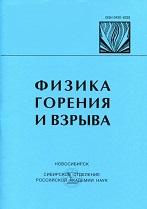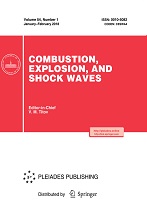|
This article is cited in 193 scientific papers (total in 193 papers)
Burning of nano-aluminized composite rocket propellants
L. T. de Lucaa, L. Galfettia, F. Severinia, L. Medab, G. Marrab, A. B. Vorozhtsovc, V. S. Sedoid, V. A. Babuke
a Politecnico di Milano, Solid Propulsion Laboratory, Milano, I-20158, Italy
b Polimeri Europa, Istituto G. Donegani, Novara, I-28100, Italy
c Tomsk State University, Tomsk, 634034, Russia
d Institute of High Current Electronics, Russian Academy of Sciences, Tomsk, 634055, Russia
e Baltic State Technical University, St. Petersburg, 198005, Russia
Abstract:
Several aluminum nanopowders were examined and compared with the final goal to evaluate their application in solid rocket propulsion. A detailed investigation of pre-burning properties by the Brunauer–Emmet–Teller method, electron microscopy, X-ray diffraction, and X-ray photoelectron spectroscopy was carried out. Ballistic properties and the combustion mechanism of several aluminized propellant formulations were investigated. In particular, aggregation and agglomeration of metal particles at and near the burning surface were analyzed by high-speed high-resolution color digital video recordings. All tested nano-powders are of Russian production; their physical characterization was carried out at the Istituto Donegani (Novara, Italy); ballistic studies were performed at the Solid Propulsion Laboratory (Milano, Italy) using laboratory and, for comparison, industrial composite propellants based on ammonium perchlorate as an oxidizer. Results obtained under a fair variety of operating conditions typical of rocket propulsion indicate, for increasing nano-Al mass fraction or decreasing nano-Al size, larger steady burning rates with essentially the same pressure sensitivity. While aggregation and agglomeration phenomena still occur, their significance may be reduced by using nano-Al instead of micro-Al.
Keywords:
composite solid propellant, nano-Al, specific surface, burning rate, pressure sensitivity, video recording, metal agglomeration.
Received: 21.06.2005
Citation:
L. T. de Luca, L. Galfetti, F. Severini, L. Meda, G. Marra, A. B. Vorozhtsov, V. S. Sedoi, V. A. Babuk, “Burning of nano-aluminized composite rocket propellants”, Fizika Goreniya i Vzryva, 41:6 (2005), 80–94; Combustion, Explosion and Shock Waves, 41:6 (2005), 680–692
Linking options:
https://www.mathnet.ru/eng/fgv1731 https://www.mathnet.ru/eng/fgv/v41/i6/p80
|


| Statistics & downloads: |
| Abstract page: | 40 |
|





 Contact us:
Contact us: Terms of Use
Terms of Use
 Registration to the website
Registration to the website Logotypes
Logotypes








 Citation in format
Citation in format 
